In both the UK and US, politicians are proposing significant, above-inflation increases in the minimum wage. The US is proposing an increase from $7.50 to $15 by 2024. The arguments for raising the minimum wages include – reduced in-work poverty, a reduction in inequality, an incentive to increase labour productivity and higher wages leading to increased economic growth. On the negative side, increasing minimum wages too fast could cause a rise in business costs, a rise in unemployment, and higher prices for consumers – problems exacerbated in depressed, low wage sectors and regions.
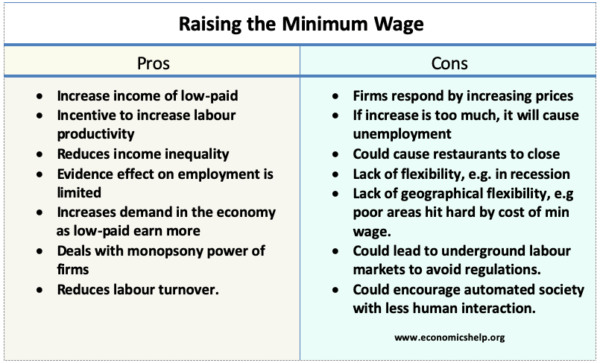
Pros of raising the minimum wage
Employment effects negligible. Free market economists, like M.Friednam feared the introduction of a minimum wage would cause unemployment because in competitive labour markets higher wages lead to less demand. However, there is significant evidence to dispute this. Since 2010, the UK minimum wage has increased far above the inflation rate – from £5.93 to £8.21 (27% increase).
UK Minimum wage
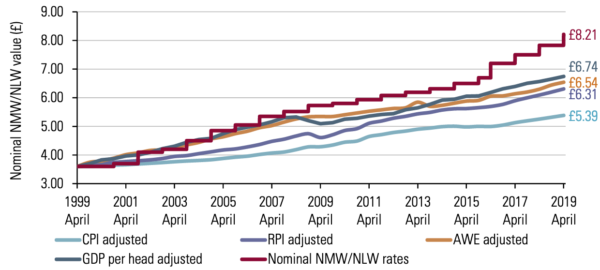
UK employment rate %
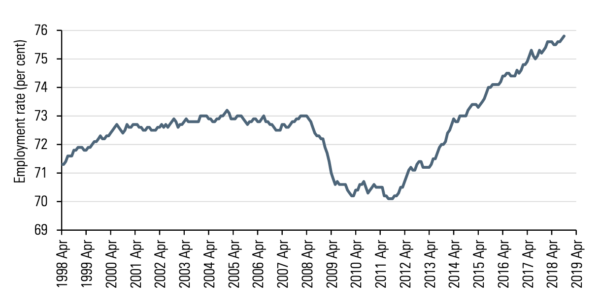
In the period (2010-2019), employment has increased sharply – despite significant increases in the minimum wage. A study by the Low Pay Commission into 20 years of the UK minimum wage found no strong evidence of falling employment due to minimum wage.
“Since 2000, we have commissioned over 30 research projects… overall none of the research that we have commissioned has shown strong evidence that minimum wages have led to falling employment.”
Low Pay Commission on history of minimum wage and its effects, 2019
It is not just the UK, but a comprehensive US study into the effect of raising minimum wages found a similar negligible effect on employment.
“Overall, these findings suggest that the level of minimum wages that we study—which range between 37% and 59% of the median wage—have yet to reach a point where the job losses become sizable.”
(NBER Working Paper No. 25434, Effect of minimum wages on low wage jobs, Jan 2019)
Counterbalance to monopsony. In the real world, labour markets are not perfectly competitive. Employers have a significant degree of monopsony power. This means they are able to pay wages below the equilibrium and take a higher share of profit. This is why increasing the minimum wage is compatible with the empirical evidence of no or little fall in employment.
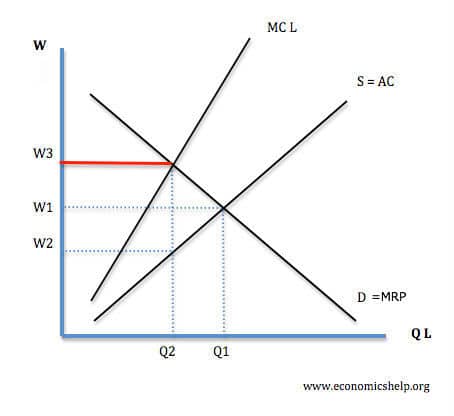
Productivity increases. A rise in the minimum wage creates an incentive for firms to invest in automation and increased labour productivity. (For example, a switch to self-service tills, increased self-service at restaurants.) This investment will help increase overall productivity in the economy and enable firms to be able to afford the wage increases. It shifts the economy to be less labour-intensive. There is some empirical evidence that an increase in the minimum wage leads to fewer hours worked as firms seek to get a greater return from labour. Productivity growth is a key factor in determining the long-run rate of economic growth.
Reduces labour market turnover. A higher minimum wage reduces labour market turnover. Workers have a greater incentive to stay in a job where they get better paid. Similarly, firms have more incentive to train higher-paid workers. Lower labour market turnover helps to reduce the costs of firms.
Reducing in-work poverty. In recent decades, we have seen low wage growth, yet living costs, especially rent has been rising above inflation. This has led to a squeeze on living standards for those on the lower-income spectrum. Many western economies have also seen a growth in inequality with the gap between high-income earners and low-income earners growing. One study in California found that:
“Our estimates suggest a 10% increase in the minimum wage would reduce household poverty rates by 0.7 to 0.9 percentage points in the highest impact areas,”
Anna Godøy and Michael Reich. (2019). “Minimum Wage Effects in Low-Wage Areas”. IRLE Working Paper 106-19r
Low-paid need the protection of the minimum wage. In recent decades, we have seen labour markets change and become more flexible – with a growth in part-time, temporary work and weak trade unions – therefore low-paid workers find it difficult to use collective bargaining to gain wage increases, and it is easy for firms to ignore wage demands. Therefore a minimum wage is playing an increasingly important role in protecting the living standards of the low-paid and minimising the gap between rich and poor. This has additional benefits for maintaining a more cohesive society and a sense of fairness.
Spill-over benefits. Most of the benefits of the minimum wage occur to the lowest-paid, but there can also be benefits to those who earn just above the minimum wage.
“For a wide range of lower-skilled workers, including those who make up to $5 an hour more than the new minimum”
The Effect of Minimum Wages on Low-Wage Jobs: Doruk Cengiz, Arindrajit Dube, Attila Lindner, Ben Zipperer (Jan 2019) NBER
Cons of raising the minimum wage
Negative employment effects. Previous increases in the minimum wage have been mostly absorbed by the economy without significant negative impacts on employment. However, there is a tipping point at which increases in the minimum wage will have a negative effect on employment. In particular, if minimum wages are increased over 60% of median wages, there is a concern that at this level, firms will not be able to absorb all wage increases through price increases and productivity gains, and therefore employment will fall.
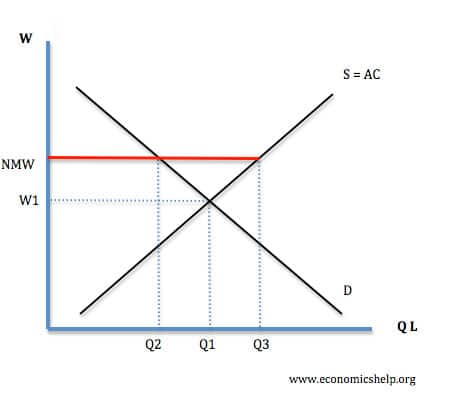
The problem is that previous success in raising the minimum wage is encouraging a rapid increase in minimum wage above a sustainable rate of increase.
Higher prices. An effect of higher minimum wages is that firms respond to an increase in costs by passing some of the costs onto consumers. Restaurant prices in California have increased as a result of the rise in the minimum wage. A study looked at the effects of a 25% minimum wage increase in 2013 in the area of San Jose, California.
“Their findings suggest that nearly all of the cost increase was passed through to consumers, as prices rose 1.45% on average.”
SYLVIA ALLEGRETTO AND MICHAEL REICH, ILR Review, 71(1), January 2018, pp. 35–63
Many labour-intensive industries, such as hairdressers, cleaners and health care workers will invariably see a rise in wage costs and prices for consumers.
- In evaluation, whilst business may experience higher prices, if all restaurants increase price together, demand may prove inelastic.
- Secondly, although costs may rise, the minimum wage does increase disposable income of poorest workers. These workers have a higher marginal propensity to consume and so may increase spending in precisely these service sector businesses.
Biggest costs in poor areas A nationwide minimum wage will have a greater impact on poor areas – regions of high unemployment and low wages. The problem is that a national minimum wage suitable for London may be unsuitable for a more impoverished area in the north. The effect on unemployment can be greater in the poorest areas.
Lack of flexibility. In a recession, demand for labour falls and there is downward pressure on wages. It is in these moments when the negative effects of a minimum wage on employment are greatest and the costs of a minimum wage highest.
Is automation always desirable? One effect of a minimum wage is to drive society towards greater automation. This can have benefits, such as greater efficiency, but if we had a society dominated by robots, this would have negative social and emotional effects. A minimum wage could (in theory!) lead to restaurants employing robots to take out food, but then we miss out on the personal interaction with humans.
Evaluation
What determines the success/failure of raising a minimum wage?
- How much is the increase? When wages are low, an increase in the minimum wage may have little effect on employment. But, that doesn’t mean, there isn’t a limit where increases in the minimum wage will cause unemployment. The trick is finding the optimal level (some suggest a rough rule of thumb 60% of median wages – but more research is needed)
- How rapid is the increase? There is evidence that when annual increases in the minimum wage are planned, firms have time to plan – increases in automation, increases in prices and therefore it is easier to absorb the increase. The biggest costs come from unexpected one-off rises.
- Do firms have monopsony power? If firms have monopsony power and are profitable, then they can afford to pay increases. If labour and product markets are more competitive, the pressure to cut jobs may be greater.
Related

You totally ignore the economic impact on those earning just above the increased amount. Employers don’t across the board increase the percentage of the lowest paid employees new found increase in their wage. So a massive portion of the work force actually receives a pay Decrease because their pay is significantly lower in respect to the cost of living increases resulting from the minimum wage increase.
The real problem is the yearly bonuses paid to CEO’s, upper level executives, middle management and store managers, supervisors etc.
The solution is to tax those bonuses with a ninety percent tax rate. To cover the welfare costs incurred to aid low wage employees who have families.
As well as redistributed to low wage workers through the Federal Income Tax Credit.
When CEO’s and their cronies in management cry foul force them to agree to peg the minimum wage to productivity, inflation and their yearly bonuses in order to get relief.
In reality those bonuses are stolen wages that were diverted from those who earned it to those sitting in the middle and at the top of the Ponzi scheme of our modern day economy.
And those people will either get better paying jobs or argue to have their wage increased. Thr companies will either pay them more or lose employees to other companies that will. The point is to raise the floor above poverty because anyone who is working should not be in poverty.
The bigger question is why is someone stuck working a min wage job? There’s so maby options our there. I do believe a increase in min wage is coming but to more than double it will cost issues for the American workforce. Right now businesses are closing due to Covid and now they have to pay more than twice for the same work force.
The number one economic goal of our elected leadership should be to get every worker out of ” a working in poverty” situation. We also need to create a wage structure that incentivizes people to get off the government dole and get a job. Lower wage earners are not only getting clipped in the pocketbook they receive less medical, sick leave, retirement benefits, etc. than all other wage earners. You can not tell me that with all the corporate executive firepower that exits in this country that a planned faze-in raise of the minimum wage could not be digested successfully in the greatest economy in the world.
You claim evidence shows no drop in employment then say “Productivity increases. A rise in the minimum wage creates an incentive for firms to invest in automation and increased labour productivity. (For example, a switch to self-service tills, increased self-service at restaurants.)” You do realize that those automated systems replace humans, thus creating more without jobs.
There is more to this than what companies has to dish out. Raising the min wage to more than twice is level will throw a lot of people of aid, unless there is new proverty level. $15 a hour is pretty good money in a lot of states and cities, Not counting states like NY and CA. You will see a lot of families SNAP be reduce and no longer able to afford insurance since they will probably be kick off Medicaid along with other programs. $15 is where your able to live but can’t afford good insurance unless the job provides it. Working a min to wage job use to provide the motivation to go to school and find a better job. Raising the wage to $15 a hour will not help someone to say there. Growth and opportunity does.
The issue with raising minimum wage is the spiral it creates in the business chain. The reality isn’t as encouraging as the fantasy. We are far too obsessed with trickle down economics. Every major company is in some capacity working with many smaller ones who deal with things like supplies or advertising. These smaller companies have even smaller ones working for them like transport and market research companies. This continues until you find a company that can’t meet the new wage requirement. So to keep making a profit they must now ask $50 more for their product or service. That causes the one buying to lose $50 anticipated profit and $50 in physical literal currency. Can Imagine who Our only hope is to implement a 1-rear price cap on base good like the ingredients to make cookies.